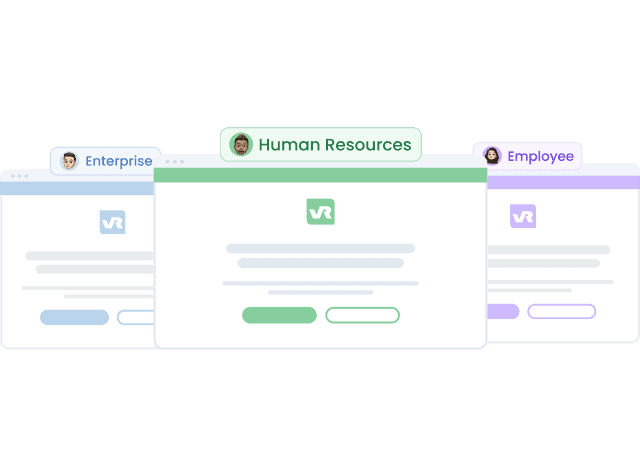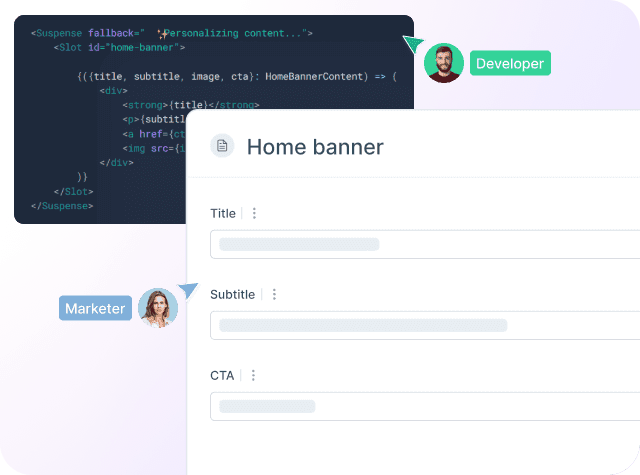In recent news, Contentful announced its acquisition of Ninetailed, a personalization and AB testing tool. This move signals Contentful's recognition of the growing demand for more tailored digital experiences.
While this acquisition aims to fill gaps in the platform, one could question whether Contentful is ready to handle personalization and AB testing effectively.
This article is for teams that use Contentful CMS and need better personalization and AB testing. Croct is one of the best cost-effective alternatives for this challenge since its component CMS can coexist with Contentful CMS. These templates give you a better look at how it works.
Experimentation infrastructures depend heavily on performance to ensure they won't negatively impact conversion rates. Having an infrastructure that was born to serve static content, will this built-in integration be enough to ensure that?
When we're talking about websites made for growth, these are usually the main requirements:
- It needs to be fast to load
- It needs to be indexed on search engines
- It needs to be scalable
- It needs to provide a good experience for content managers
- It needs to be flexible for experimentation
This post will explore what Contentful is good for, its core challenges, and how to overcome them.
Traditional CMS and AB testing platforms are no longer enough. Make your website dynamic to support the growth team's needs.

What Contentful is good for
Contentful is a headless CMS that allows developers and content teams to manage and deliver digital content across multiple platforms. Its API-first approach makes it flexible for building modern websites and applications.
Companies choose Contentful because it helps streamline content management, making it easier to deliver content to applications like:
- Static websites, like corporate, publishing, or editorial websites
- Mobile apps
- E-commerce
- Knowledge bases and documentation sites
- Industry-specific applications
However, while Contentful excels at managing content, things get tricky when you need to implement more dynamic features like personalization and AB testing.
Why Contentful isn't ideal for website personalization and AB testing
Although Contentful offers a robust CMS for managing static content, it wasn’t designed with personalization or AB testing in mind. They do have a number of technology partners and integrations in their marketplace to make it easier, but it doesn't mean it's the best option.
If you're set on using Contentful but need to incorporate experimentation features, you'll need to rely on third-party solutions.
This process can work, but it’s time-consuming, bad for performance, prone to errors, and heavy on technical teams.
Website personalization
Contentful's structure is great for delivering static content but lacks the agility needed for real-time personalization. Even with the recent Ninetailed acquisition, the integration process still requires significant effort.
Another key issue is the reliance on external vendors to achieve personalization. Every integration adds complexity and slows down the latency of the API to deliver content. Here is how the API calls look like with Ninetailed integration, for example:
- Instead of using Contentful's API to fetch the content, you need to use Ninetailed API
- Once the call is made, Ninetailed evaluates the audience segmentation, relying on another integration with your CDP of choice
- If you are running an AB test with personalized content, Ninetailed will then decide which variant should be presented to the user
- After that, Ninetailed fetches the respective content from Contentful
- Then the API returns the content to the website
There's no need to say that the latency is really high and unstable with all these external connections. So, forget about real-time website personalization with optimal performance.
AB testing
AB testing involves serving different versions of content to different user groups to measure which version performs better. Although you can create multiple content versions in Contentful, the platform doesn't offer automated traffic splitting or variant management, which is key for running effective AB tests.
If you want to run experiments to uncover the best variant of your content in terms of conversion rate, you'll also need to integrate third-party solutions into your website. The process is the same as described in the last section, but besides Ninetailed, you could also use other partners like Amplitude Experiments, VWO, Kameleoon, Uniform, etc.
Alternative for personalization and AB testing
These limitations make Contentful less suitable for marketing teams or businesses that need to personalize and optimize their website while ensuring great performance and faster page loading.
If your primary goal is having a dynamic website that gives the growth team autonomy to work independently from developers—or if your developers need to focus on core product development instead of wasting time with endless integrations—Croct offers a more seamless and powerful solution. Here's why:
-
Gradual integration
Croct can integrate with any framework, allowing you to fetch content dynamically based on user segmentation without having to modify your existing infrastructure heavily. It also allows you to work with both default and static content.
-
Unified solution
Instead of relying on multiple tools to achieve personalization and AB testing, Croct provides an all-in-one platform that works smoothly alongside your existing CMS, saving you time and effort. It also provides built-in CDP and analytics capabilities.
-
Built-in real-time personalization
Croct allows you to easily segment users based on their behavior and preferences, then serve personalized content in real-time. You don’t need to build complex logic or custom integrations, as Croct takes care of this automatically.
-
Built-in Bayesian AB testing
Croct includes native AB testing capabilities using Bayesian AB testing, allowing for more efficient tests with more confidence and statistically significant results. This helps you optimize your website or app more quickly and with less traffic.
-
Developer-friendly
With first-class support for developers, Croct offers intuitive APIs and SDKs that simplify personalization and testing workflows, reducing the need for manual implementation.
If you're curious about how Croct compares with Contentful in terms of user satisfaction, this G2 comparison gives you a pretty good overview:
| Ratings | Contentful | Croct |
|---|---|---|
| Meets requirements | 8.4 | 9.2 |
| Ease of use | 8.4 | 9/0 |
| Ease of setup | 8.1 | 9.0 |
| Ease of admin | 8.4 | 9.1 |
| Quality of support | 8.4 | 9.8 |
| Good partner in doing business | 8.6 | 9.6 |
| Product going in the right direction | 7.3 | 10.0 |
Why having 3 platforms for content management, AB testing, and personalization when you can have a single one?

But wait, I don't want to switch CMS and rebuild my entire website
Well, then, you sure don't have to.
Croct is a dynamic CMS focused on growth needs, which means you can only use it for those elements and components that you want to experiment with. In other words, Croct CMS can coexist with Contentful CMS.
Growth websites usually rely on specific elements for conversion purposes, like the top menu, banners, and forms. These elements are usually used for personalization and AB testing, while other page elements like long-format content and the footer are mostly static, so they can live in Contentful.
You can gradually move elements and components from Contentful to Croct, giving the content and the growth team the autonomy they need. Here are some templates to show you how it works.
If your goal is to create dynamic, user-specific experiences and optimize conversions without the headaches of third-party integrations, take the first step by creating your free account and get up and running in just a few hours.